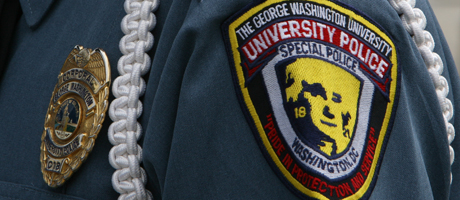GW Police Department is adding officers, working to improve coordination with MPD in effort to keep campus safe.
Last year, GW’s Police Department responded to 84,700 emergency calls, provided over 146,000 passengers rides through its 4-Ride program, and initiated more than 2,000 investigations.
This year is proving no less demanding.
“The police department works around the clock to make the campus safer for the GW community,” says Police Chief Kevin Hay, who came to GW last month with 27 years of federal law enforcement experience.
The GW Police Department’s 83 uniformed special police officers patrol campus on foot, in police vehicles and on bicycle. They have arrest authority.
The force is in the process of adding five officers to increase its patrol presence on campus. The officers will be hired by the end of the year, Chief Hay says.
In addition to police officers, the department employs more than two dozen licensed security guards, who monitor entry to residence halls and other facilities on campus.
The department also oversees the 4-Ride program, a free service that operates every night, and EMeRG, the volunteer EMS first responder agency.
To enable people to reach the police in the case of an emergency, GWPD operates a system of 39 blue light phones across campus. The lights were activated 484 times last year, the majority of which were pranks.
But, says Chief Hay, the blue lights are still a valuable resource. “If your phone is stolen, how else can you contact the police?” He says the blue lights are strategically located across the Foggy Bottom and Mount Vernon campuses. In addition, parking garages around campus are equipped with panic alarms.
Through its crime alert system, GWPD notifies the university community of violent felonies on or near campus and any other crime that poses an ongoing threat. The alerts are issued via email and posted online. Campus advisories are used to inform the GW community of emergency situations, including adverse weather or other safety issues.
GWPD is among about 1 percent of campus police departments worldwide to be accredited by the Commission on Accreditation for Law Enforcement Agencies. The police department is also accredited by the International Association of Campus Law Enforcement Administrators.
Chief Hay’s goals include reducing crime through improved patrol methods, including plainclothes details and more bicycle-trained officers. He also hopes to secure grants to improve mass notification capabilities.
He says GWPD is stepping up its coordination with D.C.’s Metropolitan Police Department. “We share information in multiple ways, including on the scene and in regular meetings.”
For example, Chief Hay now gets information from MPD on a daily basis that includes data on criminal activity around campus, including both Foggy Bottom and Georgetown.
GWPD also coordinates with the Secret Service and other agencies to protect high-profile campus visitors and can provide protection for VIPs who do not have their own detail.
So what can GW community members do to stay safe?
Chief Hay says situational awareness is critical. “Take note of surroundings and anyone who looks out of place, focusing on behavior rather than appearance.”
He urges students to walk in groups if possible and walk with keys in their hands. If driving, try to park under street lights. Rather than walk alone, use 4-RIDE. GWPD also offers a self-defense program for students, staff and faculty, he says.
Most crimes on campus are larcenies—the nonviolent theft of personal property—so students should be careful about keeping their laptops and phones with them at all times.
Crimes on campus most often happen between 6 p.m. and 2 a.m., so students should be particularly on their guard during those hours. The crime rate also increases during warm weather.
Chief Hay urges students to preprogram the GW Police emergency number (202-994-6111) into their cell phones and to report crimes or suspicious activity immediately. “Sometimes people wait a day or two, it’s much harder to find a suspect then,” he says.
“Students live in one of the safest parts of the city, but they still need to take precautions,” says Chief Hay.


